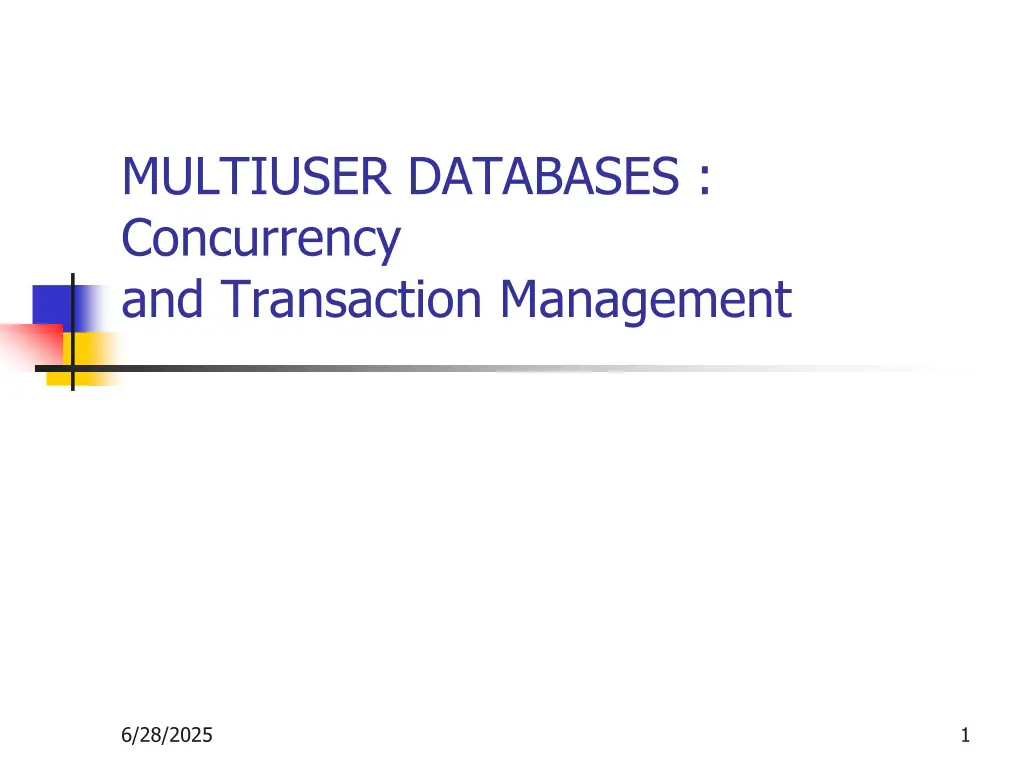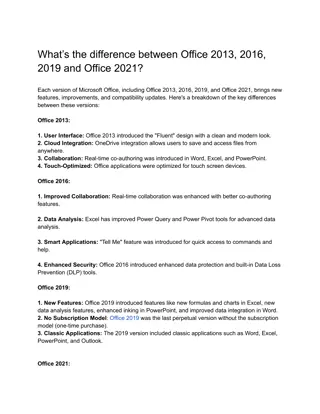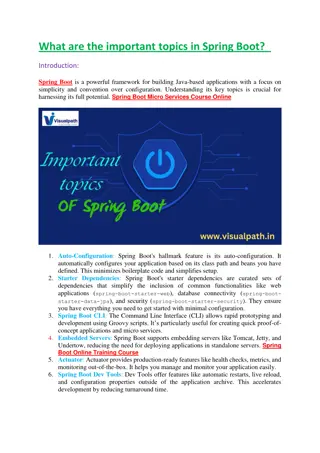
Managing Concurrency and Transactions in Multiuser Databases
Learn about the complexities of multiuser databases in operational bank applications through examples of money transfers and sum calculations, highlighting the importance of concurrency and proper transaction management to maintain data consistency and integrity.
Download Presentation

Please find below an Image/Link to download the presentation.
The content on the website is provided AS IS for your information and personal use only. It may not be sold, licensed, or shared on other websites without obtaining consent from the author. If you encounter any issues during the download, it is possible that the publisher has removed the file from their server.
You are allowed to download the files provided on this website for personal or commercial use, subject to the condition that they are used lawfully. All files are the property of their respective owners.
The content on the website is provided AS IS for your information and personal use only. It may not be sold, licensed, or shared on other websites without obtaining consent from the author.
E N D
Presentation Transcript
MULTIUSER DATABASES : Concurrency and Transaction Management 6/28/2025 1
Banking Application Entities in a banking application: Customers Employees Accounts In an operational bank database, customers use the ATMs, internet, and phones to interact with their accounts This is a multiuser database since many customers may be connected to the bank database and doing money transfers, checking their balance etc. 6/28/2025 2
Banking Application Consider that CM is transferring 100YTL from his account to BT s account. The following operations take place: Read the amount of money in the account of CM (a) a := a 100 Read the amount of money in BT s account (r) r = r + 100 At the same time, the bank calculates the total amount of money stored in the accounts Read amount of money in the accounts one by one Add the amounts to the sum. 6/28/2025 3
Banking Application BT CM 400 YTL 100 YTL 6/28/2025 4
Banking Application 100 YTL 100 YTL 300 YTL 6/28/2025 5
Banking Application 200 YTL 300 YTL 6/28/2025 6
Banking Application 200 YTL 300 YTL Sum 0 6/28/2025 7
Banking Application 200 YTL 300 YTL Sum := sum + 300 300 6/28/2025 8
Banking Application 200 YTL 300 YTL Sum := sum + 200 500 6/28/2025 9
Banking Application 200 YTL 300 YTL Things are fine if I finish the money transfer and then calculate the sum. But consider the following case 6/28/2025 10
Banking Application 100 YTL 300 YTL sum 0 6/28/2025 11
Banking Application 100 YTL 300 YTL Sum := sum + 300 300 6/28/2025 12
Banking Application 100 YTL 300 YTL Sum := sum + 100 400 6/28/2025 13
Banking Application 100YTL 200 YTL 300 YTL sum 400 6/28/2025 14
Concurrency Interleaving the execution of the operations such as the money transfer and account sum. Concurrency is needed for performance reasons (ex: using the CPU when somebody else is accessing the disk) user1 user2 user3 user4 Database 6/28/2025 15
Concurrency A users program may be doing many different operations but from a database point of view, only R/W operations are of interest. A transaction is the DBMS s abstract view of a user program: a sequence of reads and writes performed as a single logical unit of work Ex: Transaction1: R(Account1), Read(Account2), Write(Account1) 6/28/2025 16
Concurrency in a DBMS Users submit transactions, and can think of each transaction as executing by itself. Concurrency is achieved by the DBMS, which interleaves actions (reads/writes of DB objects) of various transactions. Each transaction must leave the database in a consistent state if the DB is consistent when the transaction begins. Transaction1 DB DB 6/28/2025 17
Concurrency in a DBMS DBMS will enforce some ICs, depending on the ICs declared in CREATE TABLE statements. Beyond this, the DBMS does not really understand the semantics of the data. (e.g., it does not understand how the interest on a bank account is computed). Main Issues: Effect of interleaving transactions, and crashes. 6/28/2025 18
Multiuser centralized transaction processing system. Databases and Transaction Processing Lewis, Bernstein, Kifer
Two-tiered multiuser distributed transaction processing system. Databases and Transaction Processing (Lewis, Bernstein, Kifer)
Three-tiered multiuser distributed transaction processing system. Databases and Transaction Processing (Lewis, Bernstein, Kifer)
ACID Properties of transactions Atomicity Consistency Isolation Durability 6/28/2025 22
Atomicity of Transactions A transaction might commit after completing all its actions, or it could abort (or be aborted by the DBMS) after executing some actions. Transaction Begin Transaction Commit Transaction Begin Transaction Abort 6/28/2025 23
Atomicity of Transactions A very important property guaranteed by the DBMS for all transactions is that they are atomic. That is, a user can think of a transaction as always executing all its actions in one step, or not executing any actions at all. DBMS logs all actions so that it can undo the actions of aborted transactions. LOG Transaction Begin Transaction Abort head rollback 6/28/2025 24
Transactions in SQL UPDATE authors SET au_fname = 'John' WHERE au_id = '172-32-1176' This is an auto-commit transaction with only one statement REF:http://www.sqlteam.com/article/introduction-to-transactions 6/28/2025 25
Transactions in SQL BEGIN TRAN UPDATE authors SET au_fname = 'John' WHERE au_id = '172-32-1176' UPDATE authors SET au_fname = 'Marg' WHERE au_id = '213-46-8915' COMMIT TRAN REF:http://www.sqlteam.com/article/introduction-to-transactions 6/28/2025 26
Transactions in SQL BEGIN TRAN UPDATE authors SET au_fname = 'John' WHERE au_id = '172-32-1176' UPDATE authors SET au_fname = 'Marg' WHERE au_id = '213-46-8915' COMMIT TRAN REF:http://www.sqlteam.com/article/introduction-to-transactions 6/28/2025 27
Example Consider two transactions T1: T2: BEGIN A=A+100, B=B-100 END BEGIN A=1.06*A, B=1.06*B END v Intuitively, the first transaction is transferring $100 from B s account to A s account. The second is crediting both accounts with a 6% interest payment. v There is no guarantee that T1 will execute before T2 or vice- versa, if both are submitted together. However, the net effect must be equivalent to these two transactions running serially in some order. 6/28/2025 28
Example (Contd.) Consider a possible interleaving (schedule): T1: T2: A=A+100, A=1.06*A, B=B-100 B=1.06*B v This is OK. But what about: T1: A=A+100, T2: B=B-100 A=1.06*A, B=1.06*B v The DBMS s view of the second schedule: T1: T2: R(A), W(A), R(B), W(B) R(A), W(A), R(B), W(B)
Scheduling Transactions Serial schedule: Schedule that does not interleave the actions of different transactions. T1 T2 T1: A=A+100, B=B-100 T2: A=1.06*A,B=1.06*B
Scheduling Transactions Equivalent schedules: Schedules involving the same set of operations on the same data objects Schedule 1 T1: T2: R(A), W(A), R(B), W(B) R(A), W(A) Schedule 2 T1: T2: R(A), W(A), R(B), W(B) R(A), W(A)
Scheduling Transactions Equivalent schedules: Schedules with the same set of operations on the same data objects And, for any database state, the effect (on the set of objects in the database) of executing the first schedule is identical to the effect of executing the second schedule. DB Schedule 1 DB = DB DB DB Schedule 2
Scheduling Transactions Serializable schedule: A schedule that is equivalent to some serial execution of the transactions. Schedule 1 T1: T2: R(A), W(A), R(B), W(B) R(A), W(A) Question: Is schedule 1 Equivalent to serial schedule A or B? Serial Schedule A T1: T2: R(A), W(A), R(B), W(B) R(A), W(A) Serial Schedule B T1: T2: R(A), W(A), R(B), W(B) R(A), W(A)
Scheduling Transactions If each transaction preserves consistency, every serializable schedule preserves consistency!
Anomalies with Interleaved Execution Reading Uncommitted Data (WR Conflicts, dirty reads ): T1: T2: R(A), W(A), R(B), W(B), Abort R(A), W(A), C What happens when T1 aborts?
Anomalies with Interleaved Execution Unrepeatable Reads (RW Conflicts): T1: T2: R(A), R(A), W(A), C R(A), W(A), C
Anomalies (Continued) Overwriting Uncommitted Data (WW Conflicts): T1: T2: W(A), W(B), C W(A), W(B), C
Role of a concurrency control in a database system. Databases and Transaction Processing (Lewis, Bernstein, Kifer)
Lock-Based Concurrency Control Each transaction must obtain a S (shared) lock on object before reading, and an X (exclusive) lock on object before writing. An S or X lock is released when the corresponding object is no longer needed. Ex: T1: S(A), R(A), Release_S(A), X(B), W(B), Release_X(B)
Lock-Based Concurrency Control X conflicts with X and S No transaction can obtain an X lock on an object if some other transaction has an X or S lock on that object. No transaction can obtain an S lock on an object if some other transaction has an X lock on that object S locks do not conflict with each other Multiple transactions may obtain an S lock on the same object
Lock-Based Concurrency Control Strict Two-phase Locking (Strict 2PL) Protocol: Each transaction must obtain a S (shared) lock on object before reading, and an X (exclusive) lock on object before writing. All locks held by a transaction are released when the transaction completes If a transaction holds an X lock on an object, no other transaction can get a lock (S or X) on that object. Strict 2PL allows only serializable schedules.
Aborting a Transaction If a transaction Ti is aborted, all its actions have to be undone. if Tj reads an object last written by Ti, Tj must be aborted as well! (called cascading aborts ) T1: T2: R(A), W(A), R(B), Abort R(A) ,Abort
Aborting a Transaction Most systems avoid cascading aborts by releasing a transaction s locks only at commit time. If Ti writes an object, Tj can read this only after Ti commits. In order to undo the actions of an aborted transaction, the DBMS maintains a log in which every write is recorded. Log is also used to recover from system crashes: all active transactions at the time of the crash are aborted when the system comes back up.
The Log The following actions are recorded in the log: Ti writes an object: the old value and the new value. Log record must go to disk before the changed page! Ti commits/aborts: a log record indicating this action. Log records are chained together by transaction id, so it s easy to undo a specific transaction. Log is often duplexed and archived on stable storage. All log related activities (and in fact, all CC related activities such as lock/unlock, dealing with deadlocks etc.) are handled transparently by the DBMS.
Recovering From a Crash There are 3 phases in the Aries recovery algorithm: Analysis: Scan the log forward (from the most recent checkpoint) to identify all Xacts that were active, and all dirty pages in the buffer pool at the time of the crash. Redo: Redoes all updates to dirty pages in the buffer pool, as needed, to ensure that all logged updates are in fact carried out and written to disk. Undo: The writes of all Xacts that were active at the crash are undone (by restoring the before value of the update, which is in the log record for the update), working backwards in the log. (Some care must be taken to handle the case of a crash occurring during the recovery process!)
Conflict Serializable Schedules Two schedules are conflict equivalent if: Involve the same actions of the same transactions Every pair of conflicting actions is ordered the same way Schedule 1 T1: T2: R(A), W(A), R(A), W(A) R(B) R(B), W(B) Schedule 2 T1: T2: R(A), W(A), R(A), W(A) R(B) R(B), W(B) Is schedule1 conflict equivalent to schedule2?
Conflict Serializable Schedules Schedule S is conflict serializable if S is conflict equivalent to SOME serial schedule! Schedule 1 T1: T2: R(A), W(A), R(A), W(A) R(B) R(B), W(B) Schedule 2 (serial) T1: T2: R(A), W(A), R(B), W(B) R(A), W(A), R(B)
Example A schedule that is not conflict serializable. Schedule T1: T2: R(A), W(A), R(B), W(B) R(A), W(A), R(B), W(B) Serial1 T1: T2: R(A), W(A), R(B), W(B) R(A), W(A), R(B), W(B) Serial2 T1: T2: R(A), W(A), R(B), W(B) R(A), W(A), R(B), W(B)
How to check conflict serializability? Precedence graph: (a.k.a serializability graph) One node per transaction; edge from Ti to Tj if Ti has a conflicting action with Tj and Ti precedes Tj. 6/28/2025 49
Example A schedule that is not conflict serializable: T1: T2: R(A), W(A), R(B), W(B) R(A), W(A), R(B), W(B) A Presedence graph T1 T2 B The cycle in the graph reveals the problem. The output of T1 depends on T2, and vice-versa. Theorem: Schedule is conflict serializable if and only if its presedence graph is acyclic (Proof by contradiction)






















